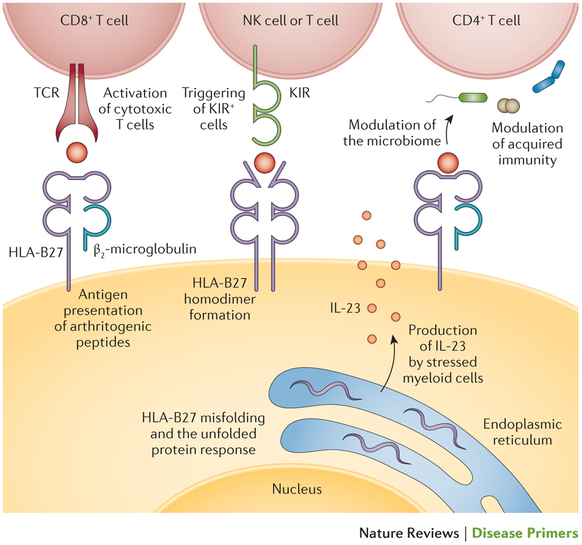Review Abstract
体軸性脊椎関節炎
Axial spondyloarthritis
2015年7月9日 Nature Reviews Disease Primers Article number: 15013 (2015) doi: 10.1038/nrdp.2015.13

体軸性脊椎関節炎には、非X線疾患とX線疾患(強直性脊椎炎としても知られる)が含まれる。体軸性脊椎関節炎の有病率を調査するためにいくつかの試験が実施されたが、大部分はX線疾患の患者に限定されていた。体軸性脊椎関節炎とヒト白血球抗原B27(HLA-B27)との間に強力な遺伝的関連があることが示されたが、HLA-B27の病因的役割については明らかにされていない。腫瘍壊死因子(TNF)、IL-17、IL-23および下流経路に対する治療の成績が良好であることから、これらの分子は重要であると思われるが、炎症過程におけるこれらの正確な役割もまだ明らかにされていない。骨増殖と炎症との相互作用を解明することは、長期の骨の構造的損傷を予防する上で重要である。体軸性脊椎関節炎患者の分類、診断およびスクリーニングの新しい基準の開発によって、この慢性的炎症性疾患の早期介入が可能となる。MRIは体軸性脊椎関節炎の早期発見に重要な方法になっている。NSAIDとTNF阻害薬は、X線変化のない早期例も含めて、有効な治療方法である。IL-17またはIL-23の阻害療法は有望な新しい治療選択肢と思われる。体軸性脊椎関節炎におけるQOLの測定方法は、本疾患によって患者が受ける影響を評価する方法に変わってきた。診断と治療におけるこれらの進歩によって、体軸性脊椎関節炎の管理は変化し続けることができ、また、本疾患の病因に関する新しい知見がこの過程を推進することが期待される。
The term axial spondyloarthritis covers both non-radiographic disease and radiographic disease (also known as ankylosing spondylitis). Some studies have been performed to investigate the prevalence of axial spondyloarthritis, although most are limited to patients with radiographic disease. A strong genetic association has been shown between axial spondyloarthritis and human leukocyte antigen-B27 (HLA-B27), but the pathogenetic role of HLA-B27 has not yet been clarified. Tumour necrosis factor (TNF), IL-17, IL-23 and downstream pathways also seem to be important — based on the good results of therapies directed against these molecules — but their exact role in the inflammatory process is also not yet clear. Elucidating the interaction between osteoproliferation and inflammation will be crucial for the prevention of long-term structural damage of the bone. The development of new criteria for classification, diagnosis and screening of patients with axial spondyloarthritis will enable earlier intervention for this chronic inflammatory disease. MRI has become an important tool for the early detection of axial spondyloarthritis. NSAIDs and TNF blockers are effective therapies, including in the early non-radiographic stage. Therapeutic blockade of IL-17 or IL-23 seems to be a promising new treatment option. Tools for measuring quality of life in axial spondyloarthritis have become relevant to assess the impact that the disease has on patients. These diagnostic and therapeutic advances will continue to change the management of axial spondyloarthritis, and new insights into the disease pathogenesis will hopefully accelerate this process. For an illustrated summary of this Primer, visit: http://nature.asia/1e1Fs54

